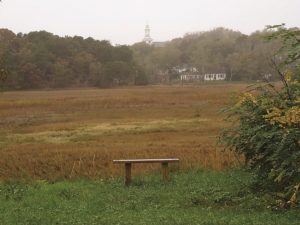WELLFLEET — She pulled up to the gas pump at the Mobil station on Route 6, but I knew she wasn’t there to fill up her tank. She was a diamondback terrapin, cruising around at the head of Duck Creek in search of the perfect spot to lay her eggs.
This terrapin was in luck. First, because I found her before she ended up under the wheels of a car. Second, because there is a spot, just behind the Mobil station, that provides an eminently suitable area for the needs of a finicky female terrapin.
The Head of Duck Creek Conservation Area was purchased in June 2011 by the Wellfleet Conservation Trust, with help from a State Conservation Partnership grant and grants from the Cape Cod Five Foundation and the Fields Pond Foundation. It was not what anyone would describe as an optimal natural conservation area.

According to Denny O’Connell, president of the trust, the site included a dilapidated building and another building foundation, and was covered with invasive vegetation. In addition, it was a Superfund site because of leaky underground storage of hydrocarbons. The trust took on the “undevelopment” process to clean up the area and, in doing so, transformed the site into a diamondback terrapin “garden” to “plant and grow” baby terrapins.
Terrapins like nesting in open, sandy areas, often in south-facing locations. With the help of many volunteers and AmeriCorps Cape Cod, the derelict building was removed, land was cleared, and invasive plants were removed. The result is an ideal nesting habitat for these salt marsh turtles.
The trust’s initiative is important for diamondback terrapins because their populations have suffered severe setbacks throughout their range. They can be found in marshes along the Atlantic and Gulf coasts of the U.S. Wellfleet is at the northernmost end of their territory.
Their decline is due to decades of overharvesting for turtle soup; they also drown in blue crab pots, are hit by cars, and are suffering from the loss of the saltmarsh habitat that is critical for their survival. They are classified as a “threatened” species in Massachusetts.
Our Wellfleet terrapins are homebodies; they stay in town year-round, nesting in many of the same spots summer after summer, and spending the winter under the mud of marshes, creeks, and the shallow waters of the harbor.
At the Mobil station, I picked up the terrapin and performed a manual pregnancy test by palpating under her shell. Noting that she still had her complement of eggs, I moved her to the turtle garden. There, she searched around, made a few moves to nest, and finally selected her spot. About 40 minutes later, after she returned to her home in Duck Creek, I was able to find her nest and protect it from potential predators, such as raccoons and foxes, by installing a hardware cloth cage called a predator excluder.
About 65 days later, a dozen baby turtles made their appearance under the excluder. I released these hatchlings into the area around Duck Creek Marsh, where they will spend about three years before they venture out and swim under Uncle Tim’s Bridge into Wellfleet Harbor.
The nest protection effort is part of a terrapin conservation project organized by the Wellfleet Bay Wildlife Sanctuary and headed by Bob Prescott, director emeritus at the sanctuary. With seasonal staff and devoted volunteers, the program has resulted in the release of thousands of baby turtles throughout Wellfleet.
It is thought that there is a high degree of mortality for terrapin hatchlings. No one knows how many will actually make it to the turtle version of adulthood. It takes five to eight years for males to mature, while females mature in the range of 9 to 12 years.
The loss of habitat for these animals due to coastal development, revetments, and other human activities has made nesting places for them rare, too. We hope that this garden will intercept terrapins coming from the salt marsh in search of nesting spots before they encounter cars on the surrounding roads.

The spot is special in one other way. Denny O’Connell reports that Head of Duck Creek is a registered monarch butterfly way station. Spikes of milkweed, the exclusive food source for monarch caterpillars, are clustered near the split-rail fence that defines the parking area.
This year, volunteers have been working in small “family units,” wearing masks, and socially distancing, as they visit the Mobil station — at this point every day — to look for the appearance of baby turtles. So far, this has been a record year for terrapin nests at Head of Duck Creek, with over 20 documented nests.
Head of Duck Creek can be visited. There is parking at the split-rail fence behind the north side of the Mobil station at Route 6 and Main Street. There you’ll find a bench for viewing wildlife and a picnic table where local folks go to enjoy their bag lunches. During June and July, you might see female terrapins climbing out of the marsh to look for the perfect spot to lay their eggs. Now it’s all about hatchlings. Both are sights to be enjoyed, but with care not to disturb either terrapins or this habitat, which is so important to their survival.
Barbara Brennessel taught biology at Wheaton College, where she is a professor emerita. She is also a volunteer at Mass Audubon’s Wellfleet Bay Wildlife Sanctuary.



